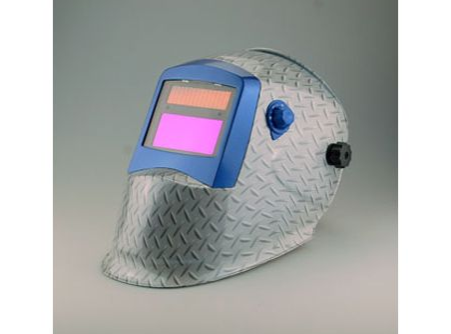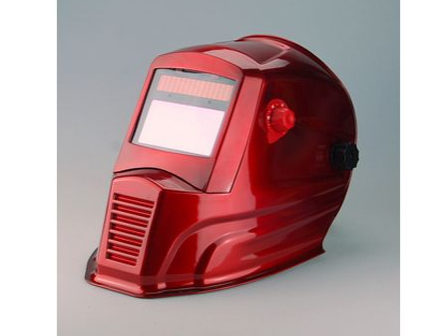Helmets are crucial to operator safety and provide protection in welding and grinding applications. A number of options are available on the market with wide-ranging features. But not all welding helmets are created equal. It’s important to understand the current and future applications and environmental needs when choosing a welding helmet.
One of the foundational features of any helmet is safety and compliance. In the United States, welding helmets need to meet ANSI Z87.1 standards, and in Canada, the helmets need to be CSA Z94.3-compliant.
Welding helmets are designed to meet these standards; the industry is really focused on protecting the welder. When a welder is choosing a helmet, it’s very much based on performance. One of the biggest trends we see is that most welders pick automatic darkening helmets with an LCD as opposed to the historical passive helmets that just have a mineral glass.

Auto Darkening Welding Helmet
Selection Considerations
The most important factors to consider when selecting an auto-darkening welding helmet are safety, comfort, convenience, and style. There are a number of general selection considerations that will help welders choose a helmet that best meets their needs, as well as finds one that wears comfortably all day on the job.
When assessing various auto-darkening helmets, look for models that have a full-coverage shell that sheds spatter and resists impact. The helmet’s viewing size also is a major factor to consider. While it is based on preference, the amount of out-of-position welding performed can affect the amount of viewing area needed in a helmet. Some of the largest view sizes in auto-darkening models have a view size that measures 97x 62 mm (3.82 x 2.44 inches) or larger, which aids in delivering a clear natural view in combination with the helmet’s LCD technology.
Also, review the helmet’s light sensitivity settings. Many helmets have settings that toggle between ranges, providing shades ranging from 6 to 9 or 9 to 13. This scale allows welders to optimize the shade for greater comfort on any given application. Anyone who moves between applications requires changes in welding machine voltage, amperage, or wire feed speed settings or changes between welding processes can benefit from this flexibility. For example, welding on thick materials at high amperages generally requires higher shade levels. Low amperage MIG or TIG welding is best performed with low shade levels to assure adequate visibility of the welding arc puddle.

Auto Darkening Welding Helmet
Some models allow the user to control delay and sensitivity. Modifying the helmet’s arc sensitivity helps assure it will darken as the user desires. For example, if there are other welders operating very close by, the helmet’s arc sensor sensitivity can be reduced to help prevent triggering or darkening when those nearby welders strike their arc.
Delay controls can be used to lengthen or shorten the amount of time it takes for the helmet to return to the light state following the completion of a weld. This can be helpful when tack welding, when the weld duration is short and the operator plans to move quickly. On the other hand, performing lengthy welds on thick materials may require that the delay be set for longer periods of time so the operator does not have to view the larger, hotter weld nugget at the end of the weld until it has cooled for a second or two. Generally, delay can be set for 0.5 seconds up to 2 seconds.
Auto-darkening helmets will feature either external or internal controls for functions like shade or grind control. The external controls add convenience, allowing some adjustments to be made while the helmet is on the head. On the other hand, external controls include additional wiring and can be exposed to additional impacts or damage as they are positioned on the outside of the helmet. Internal controls positioned on the lens cartridge are more protected and do not require external wiring, but might require removing the helmet to change settings.
If you want to get more information about the auto-darkening welding helmet, welcome to contact us today or request a quote.







